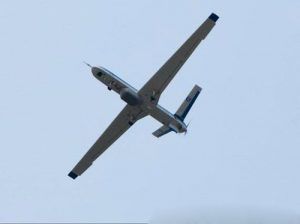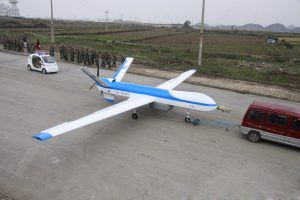
China is rapidly expanding its military presence in the disputed waters and airspace of the South China Sea.
A new high-tech surveillance drone is stalking foreign warships approaching the man-made artificial islands, creating tension in the region and a headache for the Pentagon as it feels obliged to defend and provide free navigation in what was once international waters.
The simmering tension between the U.S. and China is reaching boiling point as the two sides flirt with overt military conflict.
 The Daily Beast reports:
The Daily Beast reports:

BYPASS THE CENSORS
Sign up to get unfiltered news delivered straight to your inbox.
You can unsubscribe any time. By subscribing you agree to our Terms of Use
Deploying ships, jet fighters, and, reportedly, a high-tech surveillance drone, Beijing is moving quickly to cement its claims on strategic islands, while also forcefully rebuffing America’s own military moves in the region.
The Chinese escalation began in dramatic fashion on May 10, when the Chinese air force scrambled J-11 fighter jets to tail the U.S. Navy destroyer USS William P. Lawrence as the 500-foot-long warship sailed in international waters 12 miles from a new military installation Beijing has built on Fiery Cross Reef in the South China Sea between Vietnam and the Philippines.
A rapid-fire series of confrontations followed. Chinese jets harassed U.S. planes, sparking alarm inside the Pentagon. And the Chinese air force reportedly deployed its latest spy drone to peer down at foreign ships, presumably including American vessels.
Chinese troops occupy Fiery Cross Reef, but the Philippines, Vietnam, and Taiwan also claim the island. At stake in the China Sea disputes are control over oil and natural gas fields, and fisheries worth many billions of dollars.
The Pentagon had sent William P. Lawrence and her approximately 300 sailors to Fiery Cross Reef as part of a so-called freedom-of-navigation operation—in other words, as a reminder to Beijing that Washington does not recognize its claims on Fiery Cross Reef and other islands.
In 2014 and 2015, the Chinese government dredged around several disputed islands in the East and South China Sea, piling sand on top of delicate coral reefs in order to expand the islands and make space for ports, runways, and military installations.
The outpost construction is part of a deliberate strategy on Beijing’s part to gradually legitimize its own contested territorial claims. “China often uses a progression of small, incremental steps to increase its effective control over disputed areas,” the Pentagon explained in the latest edition of its annual report on the Chinese military.
Normally, Beijing tries to time and tailor its moves just right to “avoid escalation to military conflict,” the Pentagon’s China report noted. Rather than deploying heavily armed warships to patrol disputed waters, China usually sends lightly armed coast guard vessels—or even allegedly sponsors fishermen to sail their civilian vessels into confrontations with foreign ships.
Now Beijing’s approach seems to have changed. Either the Chinese government has miscalculated the scale and speed of its military response to the passage of U.S. ships and planes or it has switched up its strategy—because in recent months, the United States and China have definitely flirted with overt military conflict.
“In my opinion, China is clearly militarizing the South China Sea,” Adm. Harry Harris, head of U.S. Pacific Command, told Congress in February. “You’d have to believe in a flat Earth to believe otherwise.”
Amid China’s island-dredging boom, Washington organized several freedom-of-navigation operations, sending warships and warplanes to sail and fly around the new island bases.
In March, the American aircraft carrier USS John C. Stennis plus the cruisers Antietam and Mobile Bay and the destroyers Chung-Hoon and Stockdale sailed through the South China Sea, prompting Beijing to rescind an invitation for the carrier and her escorts to visit Hong Kong. William P. Lawrence’s jaunt around Fiery Cross Reef came just a few weeks later.
“This operation demonstrates, as President Obama has stated, that the United States will fly, sail, and operate wherever international law allows,” Cmdr. Bill Urban, a Pentagon spokesman, told The Washington Post. “That is [as] true in the South China Sea as in other places around the globe.”
Beijing defended its response to the destroyer’s appearance. “The American naval vessel threatened China’s sovereignty, security, and interests,” said Lu Kang, a spokesman for China’s foreign ministry. “We will take necessary measures to safeguard China’s sovereignty and territory.”
Those measures were more forceful than U.S. officials perhaps expected. On May 17, two Chinese J-11 jet fighters took off from Hainan Island, in southern China, and flew within 50 feet of a U.S. Navy EP-3E surveillance plane cruising in international airspace near the island. The J-11s edged so close to the EP-3 that the American crew had to dive to avoid a collision.
The crew surely recalled a similar incident that occurred in the same area in 2001, when a Chinese fighter actually collided with an EP-3. The Chinese pilot died. The American crew managed to land their damaged plane on Hainan. Chinese authorities detained the U.S. aviators for more than a week—and held on to their aircraft for more than three months.
The Pentagon condemned the May 17 interception as “unsafe.”
Beijing rejected that characterization. “Information from the relevant Chinese authorities shows that what the U.S. said is not true,” Chinese Ministry of Foreign Affairs spokesman Hong Lei shot back. “The U.S. Navy plane EP-3 was then conducting reconnaissance close to China’s Hainan [island]. In accordance with laws and regulations, the two Chinese military aircraft followed and monitored the U.S. plane from a safe distance without taking any dangerous actions. Their operation was completely in keeping with safety and professional standards.”
U.S. military planners were surely on edge even before China’s jets harassed the American plane. There have been several, similar close-encounters between U.S. and Russian ships and planes in recent weeks. In April, Russian bombers buzzed an American destroyer sailing in the Baltic Sea.
The same month, a Russian fighter jet flew a barrel roll over over a U.S. Air Force RC-135 spy plane flying in the same region.
With tensions running high, Beijing has made perhaps its most surprising move yet—sending into the disputed zone one of its most sophisticated surveillance drones. According to Alert 5, a highly reputable network of aviation bloggers, the Chinese air force’s brand-new Air Sniper drone, which is roughly equivalent to the U.S. Air Force’s own Reaper drone, “has been monitoring foreign warships in the South China Sea” since mid-May.
This is apparently the Air Sniper’s first frontline mission—and, of course, its first snooping on U.S. forces.
“China demonstrated a willingness to tolerate higher levels of tension in the pursuit of its interests, especially in pursuit of its territorial claims in the East and South China Sea,” the Pentagon’s recent China report stated. “However, China still seeks to avoid direct and explicit conflict with the United States.”
That could be changing. “The Chinese people do not want to have war, so we will be opposed to [the] U.S. if it stirs up any conflict,” Liu Zhenmin, vice minister of China’s Ministry of Foreign Affairs, said on May 19. “Of course, if the Korean War or Vietnam War are replayed, then we will have to defend ourselves.”
Edmondo Burr
CEO
Assistant Editor
Latest posts by Edmondo Burr (see all)
- Police Arrest Suspect In Supermarket Baby Food Poisoning - October 1, 2017
- Seoul Secures Data From Electromagnetic Interference By N Korea - September 30, 2017
- The ‘World’s First Internet War’ Has Begun: Julian Assange - September 30, 2017


Why? All of the sudden we can’t get along. Us put your “big boy” pants on and fess up. Has to be way more to this somewhere? Panetta set out to start trouble here a few years ago, so what is the truth?
Why? All of the sudden we can’t get along. Us put your “big boy” pants on and fess up. Has to be way more to this somewhere? Panetta set out to start trouble here a few years ago, so what is the truth?